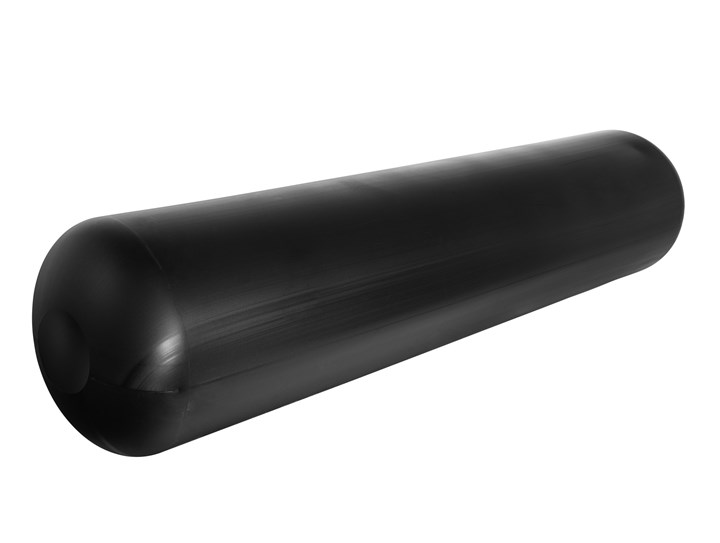320 L Hydrogen Tank Liner Blow Molded in Nylon
Large liners for hydrogen composite pressure vessels are a challenge to blow mold. Kautex found a material and a technique to achieve a world “first.”

Composite pressure vessel in Kautex lab is thermoset filament wound over a blow molded thermoplastic liner.
Hydrogen-gas-powered drive and production systems are being used in heavy-goods transport, local public transport, shipbuilding and the aircraft industry. In the future, they may prove economically feasible for passenger-car fuel cells. For some time, Kautex in Germany has been working on composite pressure vessels (CPVs) for compressed natural gas (CNG), liquefied petroleum gas (LPG), and hydrogen containment, which are produced by filament winding a continuous-fiber thermoset composite shell over a blow molded liner. Most recently, Kautex development engineers claimed to set a new benchmark by blow molding for the first time a 320-liter cylindrical liner more than 2 meters long and around 500 mm in diam.

Hydrogen CPV liner of 320 L capacity, blow molded of a special nylon.
Hydrogen, the smallest molecule in nature, can diffuse through virtually every plastic material, Kautex notes. Special polyamides (nylons) have the best hydrogen barrier properties, but their low melt strength has made them difficult to process in large-part blow molding. Newly developed grades and a special extrusion technique now make it possible for the first time to produce hydrogen liners in sizes suitable for industrial applications, Kautex states. The company considers both the material and the processing technology to be proprietary information for this development project.
“Producing a liner of this size from polyamide has been a major challenge. The work we are doing here is truly pioneering,” says Abdellah El Bouchfrati, head of Kautex’s Composite Business Development. The hydrogen CPV tanks are designed for an operating pressure of 700 bar (10,153 psi) and burst pressure of 1750 bar (25,382 psi). It must also withstand temperatures from -60 C to 120 C (-76 F to 248 F).
The 320 L liner was produced on a Kautex KBS241 accumulator-head extrusion blow molding machine, which can have a single head of 25 to 60 L capacity and a clamp of 120 or 150 metric tons. “The liner size we have now achieved is just the start,” says Bouchfrati. “We are confident that, in future, we will be able to use this method to produce considerably larger liners for hydrogen pressure vessels.”

Kautex KBS241 accumulator-head machine, an automotive-oriented model, was used for the CPV liner development.
Among recently introduced materials for hydrogen fuel tanks, DSM introduced in 2017 a nylon 6 based material, Akulon Fuel Lock; and in 2014, Ube Industries brought out Ube Nylon 1218IU, a nylon 6 that is used in the hydrogen tanks on the Toyota Mirai fuel-cell sedan.
Related Content
-
50 Years...600 Issues...and Still Counting
Matt Naitove marks his first half-century in plastics reporting, with a few of his favorite headlines.
-
First Water Bottles With Ultrathin Glass Coating
Long used for sensitive juices and carbonated soft drinks, KHS Freshsafe PET Plasmax vapor-deposited glass coating is now providing freshness and flavor protection for PET mineral water bottles.
-
How Was K 2022 for Blow Molding?
Over a dozen companies emphasized sustainability with use of foam and recycle, lightweighting and energy savings, along with new capabilities in controls, automation and quick changeovers.















